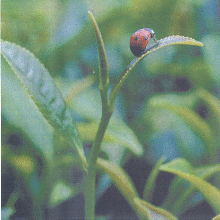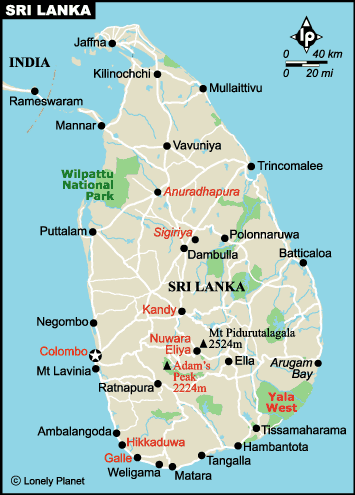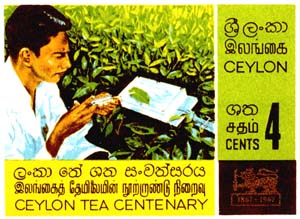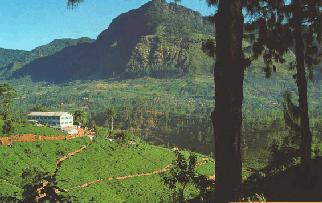|
Number 765, 2004 by Chun-Ting LEE |
Ceylon Tea |
General Information
Legal Cluster Bio-Geographic Cluster Trade Cluster Environment Cluster Other Clusters |
|
|
|||
|
Number 765, 2004 by Chun-Ting LEE |
Ceylon Tea |
General Information
Legal Cluster Bio-Geographic Cluster Trade Cluster Environment Cluster Other Clusters |
|
|
|||

1. The Issue
Since the British sailor, James Taylor planted the first 19 acres of tea in Sri Lanka in 1867, tea plantation has flourished in the elephant country. Tea for people in Sri Lanka is not only a valuable commercial crop, but also a lifestyle. Locals enjoy chewing betel nuts while drinking tea. With the unique advantage of tropical weather condition and different altitude of terrains, Sir Lanka produces tea that has its own aroma and flavors. Today, it is the world 3rd largest tea producer and tea’s economic value contributes to increasing accumulation of foreign exchanges. However, there is a tendency of substitution from tea plantation to rice cultivation through the years. Moreover, the situation of soil erosion in the upland, where tea is planted, worsens through the years because of expansion of tea production for economic development. Today, how to reach the balance between economic development and enviromental preservation is crucial to Sri Lanka.

2. Description
Tea was introduced in British colonial time in 19 century
and sprouted by James Taylor particularly. With the help from India Assam tea
planters, Taylor learned the skills and made the debut of “Ceylon tea”
to the world. The unique tropical weather and monsoons in Sri Lanka enables
tea industry to flourish. Moreover, Ceylon tea is categorized by the altitude
of plantations from sea levels. Low grown level tea grows from sea level up
to 600 meters, mid grown areas range from 600 meters to1200meters above sea
level and high grown areas are above 1200 meters. (Jayatilake, 2003). The tea
production is non-stop in Sri Lanka and the growing areas are mainly in the
central highlands and southern inland areas of the island. Main areas are Kandy,
Dimbula, Nuwara Eliya, Uda Pusellawa, Uva, and Ruhuna. Different altitude and
areas create unique aromas and flavors of their own and also attract different
buyers around the world, such as buyers Australia, Europe, Japan, and North
America adore the tea produced in medium grown areas because of its thick color
variety (Sri Lanka Tea Board).
Sri Lanka tea export reached the peak in 1960s. Depite the performance was disappointing
in the 1970s and early 1980s due to low prices and low productivity. So far
tea accounts for approximately 15 % of the agriculture exports. The scale of
Ceylon tea export expands quickly and efficiently due to government’s
promotion after independence in 1948 and also the economic liberalization in
the 1970s. Government is not able to provide adequate investments, thus, transferring
financial responsibility and management to private companies is the strategy
now.
In addition, many scientific researches and medical reports show that tea is
the most health beverage of all. It can help to prevent many types of cancer,
such as breast and skin cancers. Furthermore, more convenient ways of drinking
tea were developed in the market, for instance, instant tea or tea bags, which
also change the style of drinking tea. Convenient tea also lowers the cost and
popularizes tea culture. Tea is no longer for afternoon and for the rich only.
Today, we can enjoy great and diverse Ceylon teas due to international trade.
Despite its dominance in the market, tea industry in Sri Lanka faces many challenges
from the market. Maintaining and enhancing its tea competitiveness in the tea
market is crucial. How to expend the tea export without sacrificing its quality
and price is imperious. The tea manufacturing in Sri Lanka is orthodox method
which emphasizes on the quality of the tea. However, due to increasing demands
of cut, tear and curl(CTC) teas, which has the advantage of being a faster brewing
tea, Sri Lanka also produces it in order to meet demands. Furthermore, in order
to meet various types of demands, the productions of tea packets tea bags and
instant tea are also expending. Moreover, the tension of tea exports between
India and Sri Lanka has been reduced by bilateral free trade agreement, yet
will FTA be the ultimate solution for competition in tea businesses is questionable.
3. Related Cases
4. Author and Date: Chun-Ting LEE (Dec, 2004)
5. Discourse and Status:
Since the accession of the World Trade Organization (WTO) in 1995, Sri Lanka has devoted itself in reducing trade barriers by negotiating with other members while reforming domestic trade policies and infrastructure adjustments. Initially, the report from the WTO stated that Sri Lanka’s trade policies and practice have gradually toward more broad reform of economic liberalization, yet the pace has been slow due to macroeconomic difficulties in the late 1980s. Moreover, the report pointed out that Sri Lanka has bound all tariffs, like other WTO members, the scope of tariff for industrial products is small; the ceiling rates at the same level as for agricultural products (50 percent). Market access conditions have been improved for banking and other financial services.
Currently, there are three trade agreements to Sri Lanka, General Agreement
on Trade in Services (GATS), Pakistan Free-Trade Agreement and Indo-Lanka Free
Trade Agreement. GATS is a trade agreement that established a credible system
of international trade rules, especially for the services sectors. It promotes
trade and development through economy liberalization. It requires each WTO Member
to have a schedule of specific commitments which identifies the services for
which the Member guarantees market access and national treatment and any limitations
that may be attached. Recognizing the difficulties that developing countries
have, they are given flexible schedule for gradually opening their market.
In order to promote the development of economy relations between Pakistan and
Sri Lanka through trade expansion in goods and services, and to provide fair
competition between two countries by eliminating trade barriers, the Government
of the Islamic Republic of Pakistan and the Government of the Democratic Socialist
Republic of Sri Lanka consider the opening of their domestic markets through
commercial cooperation which is crucial for the bilateral relations.
India and Sri Lanka implement the Free Trade Agreement on March 1, 2000. Both
parties agree to phase out or even eliminate tariffs on agreed list of goods
within a fixed schedule. Moreover, both sides have their own Negative Lists,
which including items that could not enjoy duty-free with a certain time limit.
For instance, a three-year time frame for India to give duty free access to
all Sri Lankan exports, yet tea is one of the items that on India’s Negative
List because of the competition between two countries (Board of Investment Sri
Lank).
6. Forum and Scope:
Uruguay Round Agreements:
The WTO Agreement of Agriculture focus on the establishment of a fair and market-oriented
agricultural trading system through reduction in agriculture support and protection.
However, the situation is quite different in most developing countries like
Sri Lanka. Inadequate production and insufficient support to raise agricultural
productivity and food production are the realities there. Sri Lanka co-sponsored
several proposals, especially the proposal on “Development Box’
which addresses concerns from developing countries.
The recent Doha Round focuses on the concerns from developing and least-developed countries. In order to well-distribute the welfare and benefits that produced by multilateral trading system, engaging and integrating them into the system is important to the WTO and each member. Recognizing their special situations and needs and then promoting economic development are crucial. Agriculture is the most protective sector in each country and so more time is needed for negotiations, More recently, “July 2004 Package” is approved and inside the proposal, member governments have agreed to abolish all forms of agricultural export subsidies by a date certain and agreed to substantial reductions in trade distorting domestic support in agriculture. Special and Differential Treatment (WTO website)
In conclusion, most controversy in agricultural sector lies in paddy production,
not tea plantation. So far, there is no trade dispute case related to Ceylon
tea in the WTO dispute settlement body. With the Indo-Lanka Free Trade Agreement,
it is unlikely that any trade distortion would happen. Despite that tea is still
the exception in the Indo-Lanka FTA, both countries should soon negotiate further
corporation in order to gain larger share of tea market. Main tea import countries,
such as US or EU, do not impose trade barriers to hinder tea trade. In short,
Sri Lanka tea trade is expected to grow rapidly and smoothly in the future.
7. Decision Breadth:
Sri Lanka is a country that relies heavily on trade. Historically, the island exported cash crops in order to import food to its population. When the economy was liberalized in 1977, the demand for import increased and resulted in large amount of foreign trade deficit and external debt. Based on the 2003 date from World Bank, the Agriculture accounted for 19% of the GDP and tea export was around 13% of the total export (663billion/5,133billion). According to Office of the United States Trade Representative (USTR), it is one of the liberal and free traders in South Asia. it became the member of the WTO in 1995 and many of the trade policies are challenged. In order to promote trade and increase economy growth, Sri Lanka reduces trade barriers and loosens the constraints for foreign investments. Export companies approved by the Board of Investment (BOI), are generally entitled to corporate tax and holidays and concessions. Exporters receive supports from the Export Development Board in marketing. Exporters receive insurance and guarantees from Sri Lanka Export Credit Insurance Corporation (SLECIC). Value-Added Tax (VAT) is usually exempted for BOI approved projects. For some others, the VAT is refunded. The airports and ports levy on imports for exports processing is 0.5 percent .Furthermore, WTO requires members to reduce tea import duty by 24 % from the existing rates, by the year 2005. Under indo-Lanka bilateral agreement imports, tea exports from Sri Lanka area allowed at the rate of 7.5% only not 35 %.
On the other hand, import tariff is the main instrument for trade policies.
Six bands of tariff ranges from 2.5 % to 25% are currently imposed. Besides,
there are specific duties on 46 items, including 12 agriculture products. However,
the practice has not reached the requirement of the WTO rules. Tariff Advisory
Council is established to fulfill the idea of the free trade regime. Sri Lanka
imposes specific duties in garment or wheat imports for the purpose of protecting
domestic producers. However, they remain below Sri Lanka's bound agricultural
tariff rate of 50% in the WTO.
8. Legal Standing: Currently, there are three agreements, GATS, Pakistan FTA and Indo-Lanka FTA.
9. Geographic Locations
a. Geographic Domain: Asia
b. Geographic Site: South Asia
c. Geographic Impact: Sri Lanka
10. Sub-National Factors: No
11. Type of Habitat: Tropical
12. Type of Measure: Intellectural Property
13. Direct v. Indirect Impacts: Direct
14. Relation of Trade Measure to Environmental Impact
a. Directly Related to Product: Yes
b. Indirectly Related to Product: No
c. Not Related to Product: No
d. Related to Process: Yes
15. Trade Product Identification: Tea
16. Economic Data
The tea industry in Sri Lanka is its main source of foreign exchange and a significant source of income for laborers. Agriculture exports account for 21% of the GDP and especially, tea export is approximately 15% of all. According to Sri Lanka Tea Board, Sri Lanka is the world 3rd biggest tea producer. Its production is around 9% of the share globally and also accounts for 19% of the market share. And the major export countries are U.S. ($1.8 billion), U.K., Germany, Japan, and Belgium. On the other hand, import amount is about $ 6.4 billion and major suppliers are India, Hong Kong, Singapore, Japan, Taiwan, South Korea, U.K., and U.S. ($155 million) . Moreover, Russia, countries of the Commonwealth of Independent States (CIS), UAE, Syria and Turkey are Sri Lanka’s primary tea export countries (Country Profile 2004 & Sri Lanka Tea Board).

(World export of Tea, 1995 from UNESCAP)
17. Impact of Trade Restriction: Low
Since tea has been recognized as a healthy beverage worldwide, most countries have no significant barriers on tea imports.
18. Industry Sector: Agriculture
19. Exporters and Importers:
Main Exporters: Sri Lanka, India, China
Main Importers: U.S., U.K, Russia, countries of the Commonwealth of Independent States (CIS), UAE, Syria and Turkey
20. Environmental Problem Type:Deforestation/Soil Erosion
Deforestation: The country is divided into four regions: the southwest, the central highlands (Hill Country), the east and the northern lowlands. The central highlands are the coolest area, with an average temperature of 20¢XC year round. The highest peaks are Pidurutalagala (2,524 metres) and Adam's Peak (2,224 metres). During colonial times, much forest was cut for tea plantations. The country's northern and eastern areas are relatively dry where are not suitable for tea. In the 1920s, about half of the island was covered in forest. By 2000, the forest decreased to only 30 percent. Forests have been cut to expand agricultural areas and for fuel purpose. Deforestation has led to soil erosion, landslides, and floods.
Soil
Erosion: Sri Lanka has 6.55 million ha of land are where only about 50% is cultivable,
the other half is unsuitable terrain. Currently, out of the arable land, 40%
is used for plantation agriculture and 28% is for paddy cultivation and other
is under forest and wild life conservation. Moreover, there is a tendency of
substitute tea plantation to paddy growing over the years.The
choice of crops and cultivation practices in hilly regions directly affects
land degradation and soil erosion rate. In Sri Lanka, tea is the major commercial
agriculture and is planted in the central upland region were soil erosion problems
are most serious. Since tea is the main source of foreign exchange, which means
the expansion of tea production would further damage the environment. Despite
that, compare with other crops, tea is relatively benign to soil erosion. Crops
like tobacco or various forms of shifting cultivation contribute to more serious
land degradation (Jayatilleke, 2003). It is no yet clear that tea plantations
has significance imipact on damaging the environment, yet it is important to
note that there is continuing pressure between the forces who wish to continue
growing tea as a cash crop and those who would use land for fulfilling other
needs such as growing food, in most of the producing countries.
In order to protect the environment, the governments has joined Biodiversity, Climate Change, Climate Change-Kyoto Protocol, Desertification, Endangered Species, Environmental Modification, Hazardous Wastes, Law of the Sea, Ozone Layer Protection, Ship Pollution, Wetlands.
21. Name, Type, and Diversity of Species
Name: Tea
Type: Black tea or
what we called "Orange Pekoe" mainly, but most of the harvest goes
into blends.
Diversity: various
teas in China, India, Sri Lanka and Kenya
22. Resource
Impact and Effect:
Impact: High
Effect: Product
23. Urgency and Lifetime:
Seed sown tea = 75 - 80 years life
V.P. planted tea
= Ideally Low country 35 years. High grown 50 - 60 years.
24. Substitutes: other types of tea from India, China or Kenya. Maybe coffee.

25. Culture: Yes
Despite its early discovery during
Emperor Shen Nung’s period in 2737B.C.E. in Asia, Tea was unknown to Europeans
until the 16th century. With the introduction of Catherine of Braganza of Portugal
in 1662 to Britain and soon it gained popularity in the late 1700s due to stable
price and increasing tea imports from China. It was until the 1880s, tea was
grown in Sri Lanka (Ceylon).
In 1830s and 1840s, the tea clipper ships cruised between Europe and Asia increased
the amount of tea trade. It was the reason that tea was widely available to
working classes because of cheap black tea from Sri Lanka on the market in Britain
in the middle of 19th century. Tea was widely accepted by the working class
in Britain due to a temperance movement in the mid 19th century, shift from
alcohol, an emulation of the bourgeoisie and a diet habit (Wilhelm).
On the other hand, Robert Knox, who was a sailor with the English East India
Company, and was captured with his shipmates by the King of Kandy in 1960s.
At that time, they were not kept in prison, but gave the chances to live with
locals. From his memoir, Kandyans did not drink tea, but drank water and arrack,
an alcohol distilled from the sap of the Kitul Tree. The reason was that tea
was neither part of their daily life, nor hot herbal infusions were prescribed
on a regular basis. At that time, it was the betel nut that had the same social
role as tea plays in Sri Lanka now (Wilhelm).
When Britain took over Sri Lanka in the early 19th century from the Dutch, the
daily habit of tea drinking had already well established in Britain. Tea drinking
was first an emulation of the colonists from the ruling class, Mudaliyars in
Sri Lanka. Back to the Dutch colonization, the ruling class had already begun
to form and when the British took control, the Mudaliyars remained part of ruling
elite class. Tea drinking was just one of the imitations to Britain’s
lifestyle and was a step towards good social relations. Gradually, when tea
became more popular and widely used, it began to fit into Sri Lanka’s
culture. For people who were not the elite class, they began to drink tea while
chewing betel nut. It is a sign of hospitality when the host offers a cup of
tea to visitor and an establishment of social connections. Also, the similarity
between British working class and the working class in Sri Lanka is that when
food is not so affordable, they tended to drink large quantities of tea to make
cold meals seem hot. Today, many would still consider tea drinking is a symbol
of British colonization, yet others might argue its economic value in Sri Lanka’s
culture. Of course, after the colonial time, Ceylon tea develops its characters
and flavors in the world market. It still maintains the name for great tea (Wilhelm).
26. Trans-Boundary Issues: No
27. Rights: No
28. Relevant Literature
Embassy
of Sri Lanka in Berlin.
Embassy of Sri Lanka in United
States
Sri Lanka
Export Development Board
Sri Lanka Tea Board

Bibliography
Bandara, Jayatilleke S., and Ian Coxhead. “Can Trade Liberalization Have
Environmental Benefits in Developing Country Agriculture? A Sri Lankan Case
Study.” Journal of Policy Modeling. 1999. Nov. 25 2004.
< http://www.sanrem.uga.edu/sanrem/database/pdf/CanTradeLiberalization.pdf>
Board of Investment Sri Lanka. Sep~Dec, 2004. < http://www.boi.lk>.
“Country Profile 2004:Sri Lanka.” The Economist intelligence Unit. 2004. Nov.14 2004. <www.eiu.com>.
Jayatilake, Rajika. “Tea Industry
of Sri Lanka.” Oct. 2003. Oct 12, 2004.
< http://www.the-south-asian.com/Oct2003/Tea_Industry_of_Sri_Lanka.htm>.
“Land Use in Sri Lanka: Past,
Present and the Future.” Thailand Land Development Department. Aug. 2002.
Oct. 22 2004.
< http://www.ldd.go.th/Wcss2002/papers/0974.pdf>.
“Sri Lanka at a Glance.” The World Bank Group. Sep 23, 2004. Nov. 23 2004. <www.worldbank.org/data/countrydata/aag/lka_aag.pdf>.
Sri Lanka Tea Board. Sep~Dec. 2004. <http://www.pureceylontea.com>.
“Sri Lanka: Trade Summary.”
Office of the United States Trade Representative. Sep. 23 2004.
<http://www.ustr.gov/assets/Document_Library/Reports_Publications/2004/2004_National_Trade_Estimate/2004_NTE_Report/asset_upload_file10_4797.pdf>.
Wilhelm, Kandra H.. “Tea country”
Oct 13, 2004.
< http://www.panix.com/~kendra/index.html>.
Figure
"World exports of tea, 1995." Role of Tea in Development in Sri Lanka. United Nationa Economic and Social Commission for Asia and the Pacific. Nov. 27 2004. <http://www.unescap.org/drpad/publication/integra/volume3/srilanka/3sr01a.htm>.
Images
CTL3 from Lonely planet-Sri Lanka
map. <http://www.lonelyplanet.com/mapshells/indian_subcontinent/sri_lanka/sri_lanka.htm>.
CTL6 from <http://www.srilanka-botschaft.de/English%20Homepage/CeylonteaE.htm>
CTL8 from Stash Tea.< http://www.stashtea.com/w-050420.htm>.
CTL9 from Dan Civa Gallery. <http://www.dancivagallery.dk/gallery1.html>.
CTL14 from <http://www.goingpostal.cc/TeaT-shirts/Images/Big/TeaMaster.jpg>.